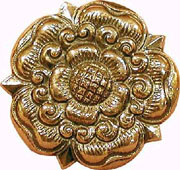WikiStrinda er Strinda historielags leksikon over historiske personer, begivenheter og bilder i tidligere Strinda kommune og Trondheim kommune, samt områder påvirket av trøndere. WikiStrinda inneholder også artikler av nasjonal interesse, spesielt knyttet til emigrasjon fra Trøndelag.
WikiStrinda er også på Facebook, besøk oss her.
Forskjell mellom versjoner av «The Rose of Trondheim»
| Linje 30: | Linje 30: | ||
[[Category: Categories in English]] | [[Category: Categories in English]][[Kategori:Midt i byen]] | ||
Revisjonen fra 1. feb. 2014 kl. 08:13
'Nyperosen' is Trondheim municipality flower. There are several wild species nyperoser in the municipality (eg. Cinnamon rose and kjøttnype).
The Rose of Trondheim is a stylized version. Already in the Middle Ages, the flower was used in symbolic form, including as one the holy Saint Olav symbols, possibly as a reproduction of the rose window at the Nidaros Cathedral.
In 16-1700-century the rose came in use in several guild marks, as for bakers, smiths and gold smiths. In the municipal context, it is known that the rose from 1689 was used by the Fire Department. In the 1700s it popped up in the city's seal instead of the three heads, in 1930 the Trøndelag Exhibition used it, in 1989 it became part of the city flag.
The Rose has from ancient times been a symbol of love. In ancient mythology that grew up from Adonis' blood as a symbol of rebirth and love beyond death, in Christian symbolism is associated with the blood of Christ, and symbolizes the heavenly love. As a "flower queen", it can also stand for the celestial Queen Mary and the virginity and innocence. In the Middle Ages, the rose - which has five petals - regarded as a symbol of man's five senses. It's also the familiarity (the term "sub rosa," under the rose, that "in confidence" comes from the carved roses that were common in the Confessional).
We find it in Luther's seal and in a number of noble brands in both England and Germany. The old Roman rose party "Rosalia" was a death cult that celebrated the 11th May and 15 June from the 1 century AD. This tradition is continued in the Italian day of Pentecost "Domenica Rosate". Maybe we should celebrate a rose festival in early summer in Trondheim, too?
Rose bushes have had wide application in practical life: The flowers have been used as a brandy- and vinkryddder, into jam and perfume. The fruits has been used to jam and wine, and bread when the corn crop was poor. The hear in the fruit has served as pinched wolves. The branches are tough and have been used as a tear peaks and hollowed out to dismissal.
In several places it is known as a calendar note, for example in Frosta where you said that it flourished when it was "seven weeks to the grain harvest." The flower is well known among the municipality's population, also as a garden plant and in the park plant areas (especially Rosa rugosa).
The stylized rose of Trondheim is a copy of the English Tudor rose.
The official Rose of Trondheim
Source
Trøndelag Department of the Norwegian botanical association v / Trond Arnesen

